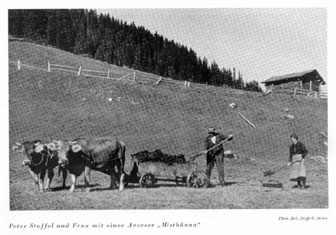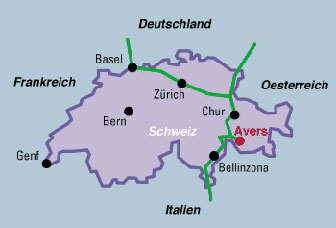Avers
|
History and Culture |  |
The first documented mention of Avers (in alpibus valli avere) is an entry found in the statute book of the Gemeinde Como from the year 1289 in connection with the settlement of Walliser mercenaries in the Hochtal Avers. Therein these people were awarded, due to damage incurred by them in a feud in the Alps of Bergells, with the authority to receive a limited collection of customs duties (1292 – 1307) from the people of Churrätien in the form of animals or goods.
It is assumed that in the middle of the 14th century Avers, at least partly, belonged to the county Schams. In the year 1377, Joannes Ossang was named the first Ammann der Gerichtsgemeinde Avers, and in 1396 led the Gerichtsgemeinde Avers into having its own seal. This is a jumping Steinbock which refers to the affiliation with Gotteshausbund.
Between 1520 and 1525 the Averser crossed over to reformation and during the time of the Bünder confusion represented French and Venetian party interests, even though the wealthy and strong family von Salis aus Soglio, from which a small part possessed the Averser citizens rights, exerted political influence.
Before the building of the Kantonstrasse and the branch of the Splügenstrasse in “Rofla” after Avers-Cresta in the years 1890-1895, only an unsatisfactory Saumweg that went to Ausserferrera outside of Aversern due to a convention with the landscape Schams, existed. Above all, the purchase of food was up until then, made during the centuries over the Stallerberg (2581m), the Forcellina (2672m) and the Madrisberg (2649m). The Averser farmers, before the building of the valley route, also sold their cattle in the upper-Italian markets.
In regards to the church the valley belonged to Avers and before the building of the first church in Avers-Cresta in the middle of the 14th century to Bivio. In 1965 in Madris a Marienkapelle built in the year 1415 was discovered. Today’s shape of the church in Cresta came about in 1786 when a free standing Campanile (bell tower) on the south side broke off and therefore a new tower was erected on the north wall of the church.
| In the
years 1958 to 1962 the building of a concrete dam and a power station took
place in Val di Lei, in association with the development of the Averserstrasse
to Avers-Juf this lead to a safe winter connection. With this improved development tourism also
bloomed (this had begun before the start of the 1st World War) and
together with agriculture has formed a substantial industry. The interest earned from the dam and from the
taxes from the power station made it possible for the Gemeinde to improve the
infrastructure in the different smaller niches and farms and thereby this
indirectly slowed the drift away from the area and the population itself
stabilised at approximately 180 inhabitants. |  |
A consequence of being so isolated has meant that Avers has, since the 14th century, remained untouched by wars and devastation and is therefore both culturally and historically valuable. There are settlement structures and other buildings from the 16th century that remain to a large extent, well preserved. They, together with the natural beauty of this valley make for a very special attraction.
Text: Jürg Stoffel









